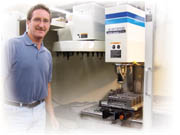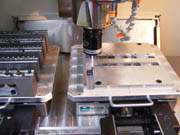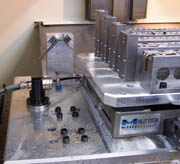
Tech Machine owner Dave Wiggans turned to creative fixturing and Renishaw probe and toolsetting technologies to automate machining of stainless and titanium medical parts. Three operators per shift oversee production of 13 vertical machining centers. The shop gets extra production by running the machines unattended after hours for one pallet cycle. Source: Renishaw Inc.
Surgeons have no room for error in the operating room. Likewise, just-in-time medical parts manufacturers cannot machine scrap if they want to be competitive, let alone profitable. Tech Machine (Colorado Springs, CO) combines probing, toolsetting, calibration and pallet fixturing technologies in an automated, quick part setup and machining system to ensure that complex-geometry parts are spot-on every time.
Since opening shop 25 years ago, Tech Machine has relied heavily on the skill of its machine operators to generate good parts. As it continued to win difficult medical work, its talented pool of labor and payroll increased. Despite a quality crew, the scrap rate continued to climb, sometimes reaching the 50% range, mainly because intricate part geometries made fixturing difficult. That is when David Wiggans, Tech Machine owner, decided to use on-machine probing to solve his scrap problem.
"After conducting a six-month study of how to become profitable and attending every seminar I could find, we decided to get good at what we do," Wiggans says. "Quite honestly, when we started the study, I thought we had a personnel problem but came to see we had a management problem. We made the decision to build our operation around the use of probing and made the commitment to master the technology."
Some told Wiggans that it takes too much out-of-cut time to run probing routines to be worthwhile. "But if a probing routine that takes 30 seconds saves me from ruining one part in a family fixture, it is well worth it," Wiggans says. "The probing routine time is immaterial-if you have a 20-minute cycle time but must scrap the part, it will take you 40 minutes to make one good part."
Wiggans began implementing his probing system two years ago, and now each of the 13 vertical machining centers in the shop operates with a probe program. "The probing system, based on a pallet fixturing system and Renishaw Inc.'s (Hoffman Estates, IL) machine tool probes, allows us to operate at one-fourth the labor, while producing a much higher volume of work thanks to speedier, more accurate setups," Wiggans says. "Our machines won't make a chip until the probing system verifies the batched parts are properly fixtured and all necessary offsets are calculated. As a result, our scrap rate has gone from 50% on some parts to virtually zero on everything."
According to Wiggans, "The probing system has transformed nearly every aspect of our machining operations. Our machines are nearly impossible to crash, and our deliveries are always on time. The probes freed up time and machinery, so our capacity went up. We're able to machine more varied and complex parts," he says. "And our customers are happy."
Tech Machine runs two 10-hour shifts, 6 days a week, with only three operators needed at a time to keep 13 machining centers running. In addition, probing lets it run unmanned in the third shift to gain extra productivity. "Using the probes, we can now leave the machines running every night and get at least one cycle out of them," Wiggans says.

Tech Machine's comprehensive probing routines locate fixtures and parts, verify setups, check tools and adjust offsets to eliminate errors. The shop's scrap rate has dropped to near zero and machines virtually never crash because a machine will not run unless it meets the initial setup conditions. Source: Renishaw Inc.
Probing for profits
Wiggans did not immediately know how big a difference probing would make to his process. His first probe, a Renishaw MP12 touch-trigger probe, came with a Fadal vertical machining center he purchased. "We had a vision of implementing probes into our process but were ‘green' when it came to probing routines," Wiggans says. "However, it was clear that our process needed help, and we ramped up as quickly as we could."At the outset, Wiggans spent three days using the probe, but did not believe the numbers coming off of it. "I simply didn't trust the data. So I actually ran 1,000 cycles, recording all the data in variables. And all the readings were within 0.0001," he says.
"We found we could run any part, any configuration or any fixture--it made no difference," Wiggans says. "We ran tests on eight different fixtures. It took 30 seconds to probe the part. On one row of parts, we saved 10 hours. When we were finished, we had a whole row of good parts."
The high-dollar stainless and titanium parts Wiggans machines have extremely intricate contours and geometries, requiring tolerances to 0.0001 and super-smooth finish. "These aren't nicely cubed parts," Wiggans says. "Flowing contours made the parts a nightmare to accurately fixture. Probing ensures the machine knows exactly where the part is located on the fixture with to-the-tenths positioning accuracy."
Wiggans uses the probes to pick up difficult part geometries and adjust offsets, as well as inside devices that define parts and pallet fixtures. Wiggans' probing process begins by having a Renishaw probe identify the multiple-part pallet loaded onto the machine bed. The probe then identifies the parts type and size and their locations in the fixture.
A family of medical parts may have only slight differences, such as number of holes or other features. This allowed Tech Machine to create one master program for an entire part family, in place of individual programs for each part. Probing identifies the part numbers-as many as 14 different individual part numbers can be run on each fixture-and their respective position in the fixture. The control then knows which parts to run from the family machining program.
The probe aligns the program to the part and checks its thickness and then finds the end of the part and resets the geometry. Prior to probing, 20% of the parts being run were scrapped because of incorrect offset errors being entered by operators. The probing software now calculates and applies all offset errors automatically.
Time and fixture savings
The probing system with pallet fixturing offers the versatility of quick setup, vital as Tech Machine's jobs vary in part quantity. "We don't have any setup downtime as parts are fixtured offline on a pallet while the machine is cutting other part," Wiggans says. "We just slide out the finished part pallet and slide in the next part batch for probing and machining. Now our spindles run all the time. This is key to meeting our just-in-time production schedules."Probing eliminates the use of expensive and very accurate fixtures that cost anywhere from $10,000 to $150,000, Wiggans says. "We no longer need high-dollar fixtures that are perfectly positioned and aligned with everything in precisely the same plane. We get by with inexpensive fixtures because the probe locates everything and compensates for uneven Z-axis depths before machining," Wiggans explains.
Wiggans redesigned all part fixtures around the use of the probe, eliminating locating pins, and wrote macro programming for the probe to find the fixture and each part automatically without operator intervention. With macro programming, the machines will run any number of parts, with any configuration, and will only run what parts are there. Tech Machine went from 200 part machining programs to five macro programs, and one employee can run as many as three families of parts.

A Renishaw TS27R toolsetting probe is mounted on the table of each machining center. Tools are brought to it for inside diameter determination and application of offsets. After completing its machining operations, a tool is checked against breakage. If a broken tool is detected, the program flags the affected part and orders the machine to switch to a redundant tool. Source: Renishaw Inc.
Automated broken tool detection
Another component of Wiggans' probing system is toolsetting with Renishaw's TS27R contact toolsetting probe. "Before, when someone put a drill in wrong, it ruined a part, and out came my wallet," he says. "We looked at toolsetting as one more factor we could make foolproof."A Renishaw toolsetting probe is mounted on the table of each machining center and tools brought to it for inspection. "We come down in Z, then over until the edge of the tool makes contact, pull up and go to the other side of the tool and find that edge," Wiggans explains. "This routine gives us the actual diameter of the tool and resets Z-axis depths." The toolsetting captures and compensates for variation with tools that may not be ground exactly the same and may have different Z-axis depths. "Using Renishaw tool setting, tight bore depths are never not right," Wiggans says.
Probing also is used to detect broken tools, which Wiggans says is particularly critical when using breakage-prone 1/8-inch drills. After performing a cutting operation on one part, the tool is delivered to the toolsetter to check for breakage. If the tool is broken, the machine will replace it and move to the next part. Wiggans programs the system to remember which part broke the tool so that the machine will skip that part on succeeding operations. This ensures that the only lost part is the one that broke the tool.
No crashes Here
With the probes inspecting setups and checking tools, plus routine calibration with Renishaw's QC10 ballbar, the machines virtually never crash, according to Wiggans. "For example, if an operator installs a pallet without clamping it down, the probe will detect that condition right away and provide an error message," he says. "If the machine ran with an unclamped pallet, every tool in the machine, the fixture and parts could be ruined. I can't think of a machine that's crashed in our shop since we implemented the probing system. We can't crash them, because the machine won't run unless it meets the initial set-up conditions."Machining centers are checked every three months with a Renishaw ballbar to verify calibration. "It's simple to hook up and run your program," Wiggans says. "It takes about 45 minutes to do a ballbar test, which tells you if anything needs attention. We keep logs to track against a motor going bad, a servo getting loose, ways getting worn or gibbs needing adjustment."
Nearly any small shop can benefit by implementing a probing methodology, Wiggans says. "To us, a machine tool without a probing system is like a machine without a spindle-it's just not complete," he says. "Probing makes your machine so much more versatile and productive that you won't know how you did it before probing.
"I call the probe my insurance policy," Wiggans says. "In effect, we've eliminated the opportunity for an operator to make an error. Now when I walk in to see customers, they're smiling. The guys in the shop feel good about making good parts, and I can sleep nights without the fear factor."
Benefits
- The scrap rate has fallen from 50% on some parts to virtually zero with the implementation of a probing system.
- Probing allows the machining centers to run unmanned during the third shift, which has increased productivity.
- On one row of parts the probing system saved 10 hours worth of probing time.
- Prior to probing, 20% of the parts being run were scrapped because of incorrect offset errors being entered by operators. Probing software now calculates and applies all offset errors automatically.
Renishaw Inc.
(847) 286-9953
Reply 12